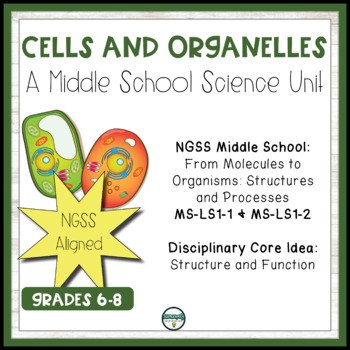Cell Unit - Parts of a Cell & Cell Organelles with Labs, Activities, Worksheets
- Zip
Products in this Bundle (5)
Also included in
- This bundle is a perfect way to introduce the basics of cells to any middle school science program. Included in this bundle are all the tools necessary to teach your students:* The basics about cell theory and cellular differentiation* The basic differences between plant and animal cells* The rolesPrice $18.86Original Price $20.96Save $2.10
- Are you looking to create a year of hands-on, interactive learning experiences for your middle school life science classroom? If so, this bundle is for you!Every lesson included in this year-long life science middle school bundle is built around phenomena for students to explore, question, and wondePrice $102.25Original Price $113.61Save $11.36
Description
This bundle is a perfect way to introduce the basics of cells to any middle school science program. Included in this bundle are all the tools necessary to teach your students:
* The basics about cell theory and cellular differentiation
* The basic differences between plant and animal cells
* The roles and functions of vital cell organelles
* How to successfully use a microscope (and how to make one!)
Students will explore and read all about cells and their organelles. They will have multiple opportunities to apply their knowledge with projects and models. Additionally, they will become familiar with how microscopes work, how they can make one themselves, and how to successfully use them to get a live view of cells.
Recommended Age Group: middle school, grades -8
The 5 lessons included in this bundle cover the following NGSS standards:
MS-LS1-1: Conduct an investigation to provide evidence that living things are made of cells; either one cell or many different numbers and types of cells.
MS-LS1-2: Develop and use a model to describe the function of a cell as a whole and ways parts of cells contribute to the function.
It also covers the following ELA Common Core standards:
SL.7.5: Include multimedia components and visual displays in presentations to clarify claims and findings and emphasize salient points.
RST.6-8.1 Cite specific textual evidence to support analysis of science and technical texts.
WHST.6-8.7 Conduct short research projects to answer a question (including a self-generated question), drawing on several sources and generating additional related, focused questions that allow for multiple avenues of exploration.
Check out each lesson to view the previews:
Introduction to Cells - Middle School
Introduction to Microscopes- how they work, how to use them, how to make them!
Plant and Animal Cells- Microscope Viewing Guide and Organelle Research Activity
A Tale of Two Cells - A project-based assessment on cells
Want the inside track to all my latest products and ideas for the classroom? Be sure to follow me on TpT or on Pinterest and check out my website!
Did you know? Your feedback is greatly appreciated AND it earns you TpT credit towards future purchases!




